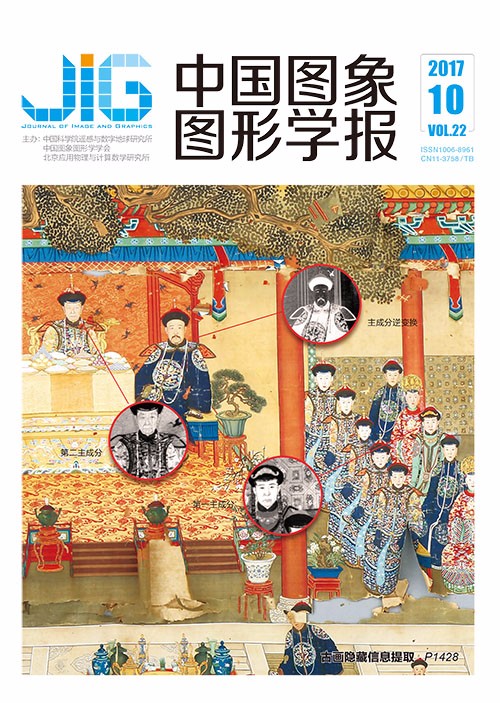
结合HSV与纹理特征的视频阴影消除算法
武明虎1,2, 宋冉冉1,2, 刘敏1,2(1. 湖北工业大学太阳能高效利用及储能运行控制湖北省重点实验室, 武汉 430068;2. 摘 要
目的 在视频监控目标检测应用中,场景中的阴影会直接影响目标检测的准确度,因此阴影抑制算法研究显得尤为重要。目前广泛使用的是HSV(hue,saturation,value)阴影抑制方法,但是该方法存在由于亮度比值的阈值不稳定而造成将运动目标也检测为阴影的问题。针对该问题,本文提出了一种结合HSV与纹理特征的视频阴影消除方法。方法 首先将输入的图像使用传统的混合高斯模型建立背景并在灰度空间中提取前景,其次在HSV空间使用亮度比的阈值方法检测阴影,二者综合得到运动目标;针对由于亮度比值的阈值不稳定而导致的前景误检为阴影的问题,采用了LBP(local binary pattern)算子结合大津阈值(OTSU)提取部分运动目标。最后将LBP算子结合大津阈值提取的部分运动目标与HSV空间检测的目标两者相或,最终去除运动目标的阴影。结果 本文选用在CVPR-ATON和CAVIAR标准视频库中多个场景的阴影视频,将本文算法与SNP算法、SP算法、DNM1算法和DNM2算法进行对比仿真,实验结果表明本文算法在阴影检测率和阴影识别率的平均值上提升约10%。结论 本文提出的视频阴影消除算法结合了HSV与纹理特征,可以在不同的环境中有效地去除阴影,运动目标保留完整,可适用于智能视频监控、遥感图像和人机交互中。
关键词
Video shadow elimination algorithm by combining HSV with texture features
Wu Minghu1,2, Song Ranran1,2, Liu Min1,2(1. Hubei Collaborative Innovation Center for High-efficiency Utilization of Solar Energy and Operation Control of Energy Storage System, Hubei University of Technology, Wuhan 430068, China;2. Abstract
Objective In the application of video surveillance target detection,the shadow will directly affect the accuracy of the target detection in the scenes,so the shadow suppression algorithm is particularly important.The traditional algorithm which is based on hue,saturation,and value(HSV) to detect shadow is popular.Inspired by color perception mechanism of human visual system,this algorithm detects the shadow by the luminance ratio between the current video frame and background model.We propose a shadow elimination algorithm based on HSV spatial feature and texture features to overcome the shortcoming of the luminance ratio between them,which causes the moving target to be mistaken for the shadow.Method The Gaussian mixture model can effectively overcome the interference caused by the change of illumination and periodic disturbance of background image.First,the mixed Gaussian model(essentially 3 to 5) is used to characterize each pixel in the input images,and the updating mixed Gaussian model is obtained after the new input frame image.Each pixel of the current image is matched with the mixed Gaussian model,and if it is successful,the point belongs to background;otherwise,it belongs to foreground.The algorithm based on HSV color space can detect the shadow accurately by calculating the luminance ratio between the current video frame and the background model because the hue and saturation values are approximate in the shadow compared with the ones in the background,and the luminance value of shadow pixels is lower than the luminance value of the background pixels.The luminance ratio between them is usually 0.7 to 1.Therefore,the moving target can be obtained by combining the foreground detected by Gaussian mixture background model with the shadow detected by the method based on HSV color space.The traditional algorithms based on HSV color space can obtain the accurate detection results,but the moving target is often mistaken for shadows seriously in the video frames.To overcome this problem,we use texture featuresthat conclude local binary pattern(LBP) and OTSU to extract the moving target.LBP is an operator of gray-scale variation.A smaller threshold is selected,which is compared with the difference value between gray value of the central pixel and gray value of its corresponding neighborhood pixel.If the difference is greater than the threshold,it is marked as 1;otherwise,it is marked as 0.Therefore,we can obtain a description of the texture change at the location of the central pixel.The LBP operator extracts local texture features by the original gray level of the image.OSTU is a maximum interclass variance method.If the shadow and the target have large variances,then the two parts have much difference.When the partial target is regarded as shadows or part of the shadow is regarded as the target,the difference of two parts becomes smaller.Thus,the largest variance segmentation between classes can result in a minimum probability of misclassification.According to the gray feature of image,the image is divided into the shadow and the target by OTSU.The complete moving target is obtained by OR operator of combining the foreground,which is respectivelyextracted by OTSU and LBP operator with the result that is extracted by HSV.Result The proposed algorithm is applied to several different shadow videos,which are included in CVPR-ATON standard video library and CAVIAR standard video library.Experimental results show that when the threshold of luminance ratio,which is applied to detect the shadow in HSV color space,remains unchanged,the moving target is extracted accurately and its shadows are basically eliminated.Compared with other traditional algorithms,such as statistical parametric(SP) approach,statistical nonparametric(SNP) approach,and two kinds of deterministic non-model(DNM1,DNM2) approach,the proposed algorithm obtain the better result.Experimental results show that the proposed algorithm has much better increment of about 10% than the forehead algorithms in terms of the average of shadow detection rate and shadow discrimination rate.Although in the Intelligent Room video,the shadow discrimination rate is 1.6% lower than that of the DNM2 algorithm and the shadow discrimination rate is 2.9% lower than that of the SP algorithm in the video of Laboratory;thus,the algorithm improves the shadow detection rate by 29% and 27.2%,respectively.In the real-time test,this algorithm can process 12~15 frames per second,which can satisfy the real-time needs.Conclusion Although the traditional algorithms that use HSV has great effect in the shadow elimination,the moving target may easily be interpreted as the shadow.The texture featuresthat include LBP and OTSU can make up for this shortcoming,wepropose the video shadow elimination algorithm by combining HSV with Texture features.Compared with other algorithms,our method can obtain more accurate shadow detection result and has much better advantages in terms of average shadow detection rate and shadow discrimination.Our method can be applied to intelligent video surveillance,remote sensing images,and human-computer interaction.Our future work will focus on improving the real-time performance.
Keywords
shadow elimination HSV(hue,saturation,value)color space value LBP(local binary pattern) operator OTSU threshold applicability
|



 中国图象图形学报 │ 京ICP备05080539号-4 │ 本系统由
中国图象图形学报 │ 京ICP备05080539号-4 │ 本系统由